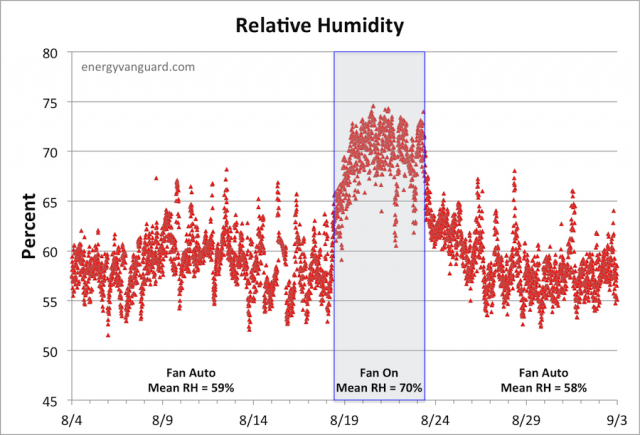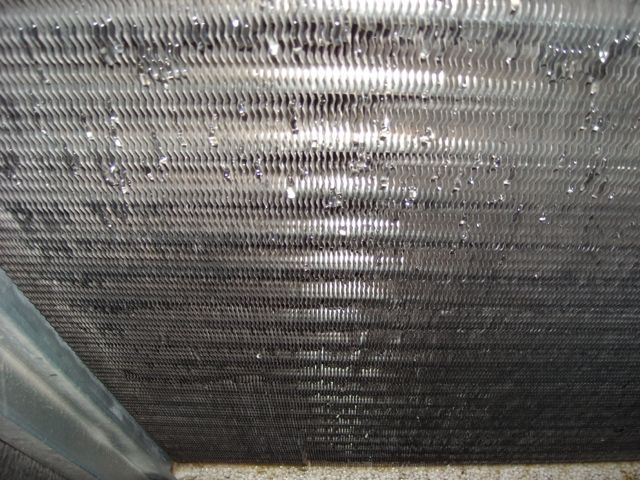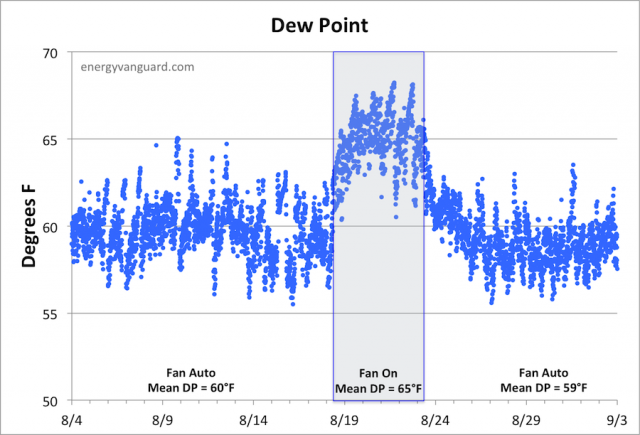
Image Credit: Energy Vanguard
I’ve been experimenting with my family lately. Or is it, experimenting on my family? In either case, I’ve got the data to confirm something I wrote in a 2011 article.
But before I tell you what I did, first let me show you what happened. In the graph at right, you can see Exhibit A: a moisture mystery. What do you think happened to cause the humidity (blue data) in the air in our condo to rise like that?
Why did the humidity spike?
The graph at the upper right shows the temperature and dew point, measured with a data logger on the main return grille in the living room, from early August to early September. The indoor temperature in our condo stayed mostly around 75°F, with a few excursions when we adjusted the thermostat. But the humidity showed something really interesting.
Starting on August 18th and ending on the 23rd, the dew point took a significant jump upwards. It had been averaging about 60°F, and then shot up to about 65°F for a few days before coming down.
Here are a few hypotheses:
Well, it was none of the above. The answer is given in the two graphs below.
This thermostat setting is to blame
At about 8:00 a.m. on August 18th, I changed the thermostat fan setting from “auto” to “on” and ran it that way for the next five days. As you can see in the graph at left, the relative humidity (RH) also spiked and averaged 70% during the time the fan was running continuously.
Why did the RH and dew point go up? While the air conditioning cycle was running, the indoor coil got cold.
Water vapor from the air passing over it would condense on the coil, as you can see in the photo at left, because the coil temperature is below the dew point of the air. A typical air conditioner can have a pound or two of water sitting between the fins, which is a pint or two in volume.
When the compressor turned off, the coil would warm up. The water remaining on the coil normally would mostly just sit there until the next cycle, with a small amount of it evaporating and sitting in the air inside the coil housing. But with the fan running continuously, the air passing over the warming coil would evaporate that water and put it right back into the house.
Keeping the relative humidity at 70% is not a good thing. That’s about the threshold where mold can really take off. If we left our thermostat set to the fan-on position all summer, I’m sure we’d have a mold factory in our condo. So if you’ve been told to run the fan continuously by someone who sold you an electrostatic filter, UV lights, or some other indoor air quality device, you may not have been given the complete story on how such products affect the IAQ in your home.
The higher relative humidity also meant that our home was less comfortable. We average about 58-59% with the fan set to auto, and even that’s not ideal. The main reason for that is the short run times of our air conditioner, which I wrote about last week.
The graph at left shows the dew point data by themselves with the mean values before, during, and after the fan-on period.
One thing that surprised me was how quickly the humidity rose when I changed the thermostat setting. Within minutes, I noticed the RH reading moving up. But getting back to RH levels below 60% took a couple of days after I switched it back to the “auto” position.
Why you shouldn’t leave your thermostat set to the fan-on position
I described the reasons not to set your thermostat to the fan-on position in my previous article, but I’ll restate them here:
- If you’re in a humid climate, you may push the air in your home into the mold-growing range of relative humidity, especially if your air conditioner is oversized.
- Your energy bills will be higher.
- You’ll increase your total duct leakage because the fan will be running all the time.
- If you have unbalanced duct leakage, you may also increase the air leakage across your building enclosure.
Don’t believe me? Do the experiment yourself.
Allison Bailes of Decatur, Georgia, is a speaker, writer, energy consultant, RESNET-certified trainer, and the author of the Energy Vanguard Blog. Check out his in-depth course, Mastering Building Science at Heatspring Learning Institute, and follow him on Twitter at @EnergyVanguard.
Weekly Newsletter
Get building science and energy efficiency advice, plus special offers, in your inbox.


















3 Comments
What would be the correct strategy for RH control ??
http://montreal.weatherstats.ca/metrics/relative_humidity.html
Have a look at those charts ... it is very difficult to get in the 50% range indoors here
through out the summer ... very easy to be in the high 60's unfortunately.
http://www.weather-and-climate.com/uploads/average-relative-humidity-canada-montreal.png
I recently discovered that mini splits need to be cleaned more than usual in a not so cooling climate i live in .. way too much humidity, not enough heat for the AC to run long and strong enough for any real dehumidification ( 1 mini split removed less than 1 liter in a week set at 22c last week )
That caused mold to take part in the lightly dust covered always humid blower wheel section.
And i have 2 dehumidifier running almost 20% of the time just to get down to 55-60%.
Heck i haven't even installed my HRV yet.
I have questionned a few neighbors and they have similar problem where their AC doesn't run enough to remove humidty and they need to run basement dehumifiers all through summer.
We need a strategy!
some systems make bad assumptions
I had to jump through a few hoops with Daikin "application
engineering" to learn how to configure their reworked Goodman
air-handler to *not* run the fan all the time, but kill it
after any given cooling cycle was over. The ECM fan still
has a programmed-in post-run time of 3 minutes, but that's
tolerable as it's about the right time to let the coil
warm up to the point where it's no longer extracting
moisture but not sit there throwing all that coil load
right back into the rest of the house. I was frankly
astounded that the default setup was so lame and ill-
considered in this regard. There's not even any good
reason for continuous fan run in heating mode, either,
and the "field settings" I needed to change are actually
separated per mode so multiple items need to be programmed..
The coil and tray hold about 2 pints after the system has
shut down and finished draining, which is far better left
sitting in the bottom of the air handler than being pushed
through the ductwork and back into the house. Once I
figure cooling season is done, I shop-vac all that icky
condensate water out of there and leave it nice and dry.
_H*
UV, HEPA filters... living in a sterilized container
Life is best lived in moderation if one wants to live.
Too dirty is not good we all know that. So clean is good but sterile clean can be too clean unless you are already immunally compromised.
Our individual and group immune systems work best in the world not contained in UV HEPA sterilization isolation unit being sold as a upgrade to one's HVAC system.
I could be wrong if so point me.
Allison, check out someday the beauty of living more north and higher in the mountains or on a breezy shore...life without AC and open windows... that is living my man. That is life. We have outback PHDs here too even...
Edit; Just read Hobbits post... maybe UV light is needed if the dang AC units have sitting filthy water in them. Seems like the design is horrible. In the homes I work on there is no easy access to cleaning the pans or any inside part of the AC section. It can be done but not like changing the furnace filter.
Log in or create an account to post a comment.
Sign up Log in